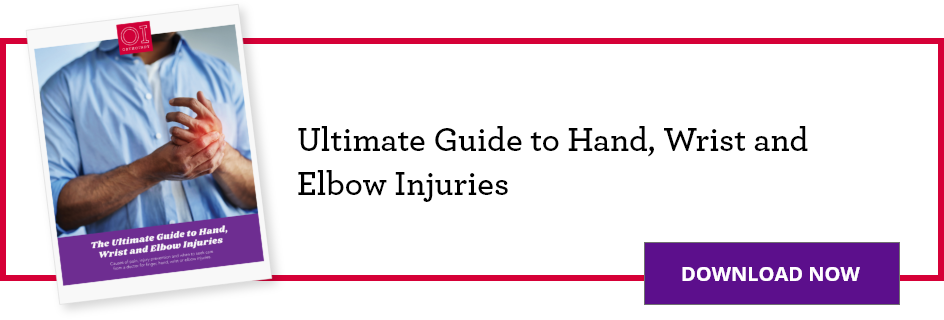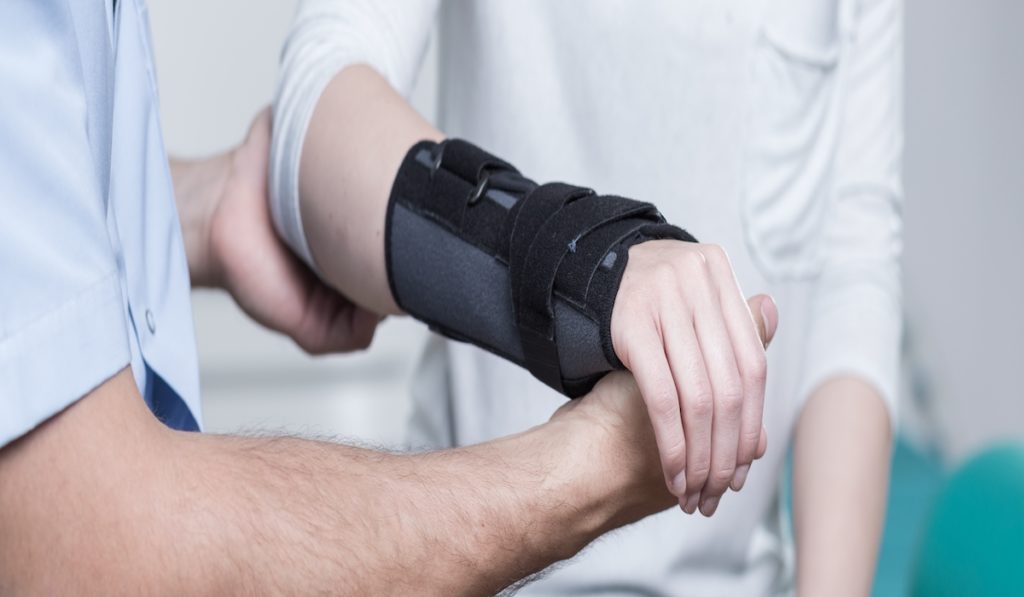THIS IS PART OF THE ULTIMATE GUIDE TO HAND, WRIST AND ELBOW INJURIES
Wrist arthrodesis, or wrist fusion, is the surgical procedure that fuses the forearm with the bones in the wrist. This surgery is used to relieve pain and stabilize your wrist, usually after trauma or severe arthritis.
Dr. Tim Dicke, OrthoIndy hand, wrist and elbow specialist, discusses the benefits of wrist fusion and how long recovery takes.
Anatomy
Your wrist joint has many joints and bones that make it up. Eight bones called carpal bones connect the bones in the forearm to the bones in your hand. Cartilage is the thick white tissue at the end of your bones that connects them to each other.
Your cartilage acts as a cushion between your bones, so they can glide smoothly while you’re moving. If your cartilage is damaged or worn down, you may experience arthritis. If you have severe arthritis, you may be a candidate for a wrist fusion.

When to have a wrist fusion
A total wrist fusion is often used as a last resort. Your surgeon will likely suggest a partial fusion or a joint replacement before going the route of a total fusion. The exceptions to this rule are patients who come in with traumatic injuries or young patients who suffer from severe arthritis and only want one surgery to correct the problem.
“Although we have the technology for an artificial wrist replacement, the wrist fusion remains a more common procedure as it has better long-term durability with less risk for future surgery,” Dr. Dicke said.
The goal of wrist fusion surgery is to make all of the bones in your wrist, hand and forearm grow together into one solid bone. This will help your bones no longer rub together from a lack of cartilage and should allow swelling to go down.
This surgery will fuse the radius in your forearm, your carpal bones in your wrist and your metacarpal bones in your hand into one bone. The ulna in your forearm is not part of this fusion because it’s what gives you the ability to twist your wrist to see the back and palm of your hand.
MAKE AN APPOINTMENT WITH AN ORTHOINDY HAND, WRIST AND ELBOW SPECIALIST
Wrist fusion surgery
After you are given anesthesia, you will be positioned so your surgeon can see the back of your wrist and hand. Wrist fusion surgery typically lasts about an hour.
After the area is sterilized, your surgeon will make a small incision along the back of your wrist to remove any remaining cartilage and reposition any bones that are not aligned.
Next, bone grafts will be placed between the gaps so the bones can be fused. A metal fusion plate is put over the radius in your forearm and the carpal bones in your hand and is secured to the bone with screws. This metal wrist fusion plate will keep your bones in place while the fusion is happening.
Your surgeon will close your incision and your arm and wrist will be casted. This surgery usually can be done in outpatient fashion, and typically you may leave the day of your surgery.
How long does a wrist fusion take to heal?
You may be wondering what to expect after wrist fusion surgery. Your wrist will have to be in a cast up to your elbow for about six weeks so the ends of your bones can fuse together. Keeping your hand and wrist elevated after surgery is essential to prevent swelling and discomfort.
“Total wrist fusion recovery time typically takes at least three months for bone healing and improves through the first six months,” Dr. Dicke said. “The patient adapts well to the loss of motion after the first year.”
Life after wrist fusion
“Once healed, your wrist fusion should last forever and usually doesn’t require additional surgery besides possible hardware (plate) removal,” Dr. Dicke said.
After six weeks, your cast is removed and replaced with a removable splint to wear another six to eight weeks. Your splint should only be taken off when you do your physical therapy exercises.
When you begin therapy, your physical or occupational therapist may massage your wrist to reduce the pain and swelling from surgery
ORTHOINDY PHYSICAL THERAPY EXERCISE VIDEOS
Once your pain and swelling are reduced, you will begin gentle exercises to increase your range of motion.
When your range of motion starts to return, you will begin strengthening exercises, so your hand and wrist move safely. This may include re-learning how to do basic daily activities without having to bend your wrist.
Your loss of movement in your wrist from a total wrist fusion will feel similar to if you wore a splint on your wrist. Activities requiring you to twist or bend your wrist may need to be done with your other wrist.
“A wrist fusion remains a valuable procedure with a reliable result of pain relief and stability,” Dr. Dicke said. “Patients accommodate well with the loss of motion, especially if they already have stiffness or painful motion from the wrist arthritis or injury.”
Learn more about hand, wrist and elbow treatment at OrthoIndy.
Schedule an appointment
Your well-being is important to us. Click the button below or call us to schedule an appointment with one of our orthopedic specialists. If your injury or condition is recent, you can walk right into one of our OrthoIndy Urgent Care locations for immediate care. For rehabilitation and physical therapy, no referral is needed to see one of our physical therapists.





